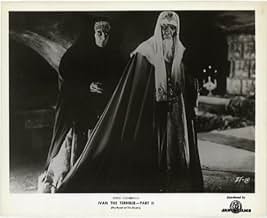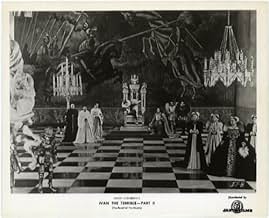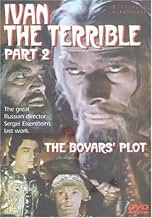La conspiración de los boyardos
Título original: Ivan Groznyy. Skaz vtoroy: Boyarskiy zagovor
CALIFICACIÓN DE IMDb
7.7/10
8.5 k
TU CALIFICACIÓN
Agrega una trama en tu idiomaAs Ivan the Terrible attempts to consolidate his power by establishing a personal army, his political rivals, the Russian boyars, plot to assassinate their Tsar.As Ivan the Terrible attempts to consolidate his power by establishing a personal army, his political rivals, the Russian boyars, plot to assassinate their Tsar.As Ivan the Terrible attempts to consolidate his power by establishing a personal army, his political rivals, the Russian boyars, plot to assassinate their Tsar.
- Dirección
- Guionista
- Elenco
- Premios
- 1 nominación en total
Vsevolod Pudovkin
- Nikolay the Fanatic
- (as V.I. Pudovkin)
Ada Voytsik
- Elena Glinskaya, Ivan's Mother
- (as Ada Vojtsik)
Aleksandr Rumnev
- The Stranger
- (sin créditos)
- Dirección
- Guionista
- Todo el elenco y el equipo
- Producción, taquilla y más en IMDbPro
Opiniones destacadas
10zetes
There is not a single criticism I could make for either Ivan the Terrible Film. They are perfect films, original, effective, and affecting. Perhaps the two best films ever made. If not, they're to be included on my list of totally invaluable films, with not a doubt in my mind.
II begins exactly where I ends. Ivan has consolidated his power in Moscow, at least with the people (though not with the nobles, or "boyars"). In fact, what power he has inspires jealousy and fear in the boyars.
Ivan I builds Ivan up as a noble character. We despise the boyars for their flagrant wealth and greed, and we like Ivan for supporting the people. His closest comrades seem like Homeric heroes.
Ivan II develops Ivan's character even further. He may have power, but he still feels alone on the throne. His two greatest friends have left him, one gone to religion and one to the enemy. His immediate underlings, perceived as heroes in Ivan I, have grown paranoid and powerful. They convince Ivan to execute left and right. The only route for the boyars is to conspire Ivan's death.
Ivan II leads up to one of the single greatest climax I can think of. To heighten the effect, for the first time, Eisenstein opted to shoot in color. And as masterful as he was with black and white, he is also with color. The juxtaposition of color with black and white is absolutely amazing.
The only problem with the film is no one's fault. Part II ends, open for the third installment. Alas, Sergei Eisenstein would die before its completion. We're lucky enough to have Ivan the Terrible Part II, for Stalin demanded that it not be released theatrically, believing Ivan to be a portrait of himself. Eisenstein, in fact, never had the chance to see it released theatrically, was never to hear the lavish praise from critics the world round. Here I praise it, hoping that in the next world possibly Eisenstein can know what masterworks he made.
II begins exactly where I ends. Ivan has consolidated his power in Moscow, at least with the people (though not with the nobles, or "boyars"). In fact, what power he has inspires jealousy and fear in the boyars.
Ivan I builds Ivan up as a noble character. We despise the boyars for their flagrant wealth and greed, and we like Ivan for supporting the people. His closest comrades seem like Homeric heroes.
Ivan II develops Ivan's character even further. He may have power, but he still feels alone on the throne. His two greatest friends have left him, one gone to religion and one to the enemy. His immediate underlings, perceived as heroes in Ivan I, have grown paranoid and powerful. They convince Ivan to execute left and right. The only route for the boyars is to conspire Ivan's death.
Ivan II leads up to one of the single greatest climax I can think of. To heighten the effect, for the first time, Eisenstein opted to shoot in color. And as masterful as he was with black and white, he is also with color. The juxtaposition of color with black and white is absolutely amazing.
The only problem with the film is no one's fault. Part II ends, open for the third installment. Alas, Sergei Eisenstein would die before its completion. We're lucky enough to have Ivan the Terrible Part II, for Stalin demanded that it not be released theatrically, believing Ivan to be a portrait of himself. Eisenstein, in fact, never had the chance to see it released theatrically, was never to hear the lavish praise from critics the world round. Here I praise it, hoping that in the next world possibly Eisenstein can know what masterworks he made.
10rnair
This space can't afford me the kind of gargantuan platform needed to speak on Eisenstein's masterwork (both parts) with the sort of attention to detail and passion that the director brings to the story of the Russian tsar. This is the rarest of films that stands as a testament to how cinema can extend beyond an entertainment and exist as a singular work of art and a document that works to expand our knowledge of the human condition. Every frame is rich, every scene speaks far more than any written line or action. The production is a phenomenal achievement in the absolute totality of the collaborative effort; the actors, the set, the cinematography, the soundtrack - every facet of the film-making process has worked to create a seamless connection. While the approach of the actors, the lighting and the choices of camera angles frustrate our standard ideas of what a movie should look and feel like, there is a design here; it is precise and it is brilliant. This is a film for those viewers who, as Eisenstein famously said, read (not just watched) the images on the screen. One of the two or three true masterworks in the history of movies.
10matzoni
Like the first part of the movie "Boyarsky Zagovor" (Conspiracy of the Boyars)is indeed a film about Stalin (who was a great admirer of Ivan the IV.) and the (seem-to-be)mechanics of power itself. The ideology, which is acted out (or reflected?!) stays much the same: one people/one leader is the ideal and necessary state of the (russian) nation, enabling it to take up with the other nations ("the Germans")The terror on the boyars and the elimination of some of them reflects Stalin's paranoiac action on comrades, subaltern party-members with the help of the "oprichniki" (here: Beriya and consorts). For instance, once in the movie, Ivan makes 'one of his best friends' the metropolit of Moscow, but in the same sequence is persuaded by the oprichniki's leader to kill his relevant to make him scared of Ivan's power. Because of this illustration of paranoiac stalinist mechanism, I can't agree on the popular notion, that the second movie is not as good as the first. One more reason: the most startling child actor ever: Erik Pyryev as the young tsar, ordering the chief boyar to be lashed.
It's great art.Eisenstein can be compared to Michelangelo,no less.Needless to say,you've got to see part one -slightly inferior to this one,but what does it mean,when you' re watching the seventh art at the height of its terrible powers?-.This part focuses on the feud between Ivan and his aunt who tries to replace him by an effeminate imposter of her choice.Prokofiev music gives the feeling of watching an opera,the scenes in the cathedral recreate a mystery as it was in the Middle Ages as faithfully as you can wish.The peak of the movie remains the banquet,shot in color,thanks to spoils of war film.So stunning is Eisenstein's mastery of the picture that you can hardly exactly tell when the color returns to black and white (which for the final becomes a color in itself)Ivan's last soliloquy might seem aggressive and chauvinistic.But you've got to remember that the USSR were at war at the time ."Ivan" is timeless ,a monument that's as awesome today as it was for its -deleted,because of Stalin- 1958 release.
While the first part of "Ivan the Terrible" is unique, stylized and powerful historical chronicle, second part is something more: poignant tragedy of authority. Since boyars poisoned Ivan's wife and his friends betrayed him, tsar remains in lonely. Oprichniki are only people he can trust. Ivan orders to kill some of boyars for instance, then Efrosinia Staricka (his aunt) sets plot against his life. One word gives atmosphere of this film: paranoia. Every character cares burden of fear - about his life, about his political business. Pervasive fear is delivered to us with unearthly dance of shadows, dramatic Prokofiev's score, haunting acting, poetic dialogs, monumental decorations and costumes. Everything looks very artificial but, paradoxically, not false; this film works with peerless emotional strength and brings as much true about authority as Shespeare's best works, being compatible to Maciavlelian theory of authority. There are only few films in history of cinema that so heavily consider problems of power (I'd mention "The Godfather, Part II" and Kurosawa's "Kagemusha" and "Ran" beside "Boyars Plot"). Don't miss. And if you decide to watch this film, I recommend: take great Criterion DVD box set which contains also first part and "Alexander Nevsky", another Eisenstein's sound masterpiece.
¿Sabías que…?
- TriviaThis film was withheld by Soviet authorities by order of Joseph Stalin, since this film, dealing with Ivan's slide into madness and the tyranny of the Oprichnina, did not properly mythologize Ivan IV Grozny to Stalin's satisfaction. It was not finally released until 10 years after the deaths of director Sergei Eisenstein and Stalin.
- ErroresIn the movie young Ivan IV is making a contract with the Livonian Brothers of the Sword. However it didn't exist since the 7th June 1238, almost 300 years before Ivan was born.
- Citas
Czar Ivan IV: From now on I will become the one you call me. I will become terrible.
- Créditos curiososThe main cast and their roles is read by the narrator with accompanied footage.
- ConexionesFeatured in The Secret Life of Sergei Eisenstein (1987)
Selecciones populares
Inicia sesión para calificar y agrega a la lista de videos para obtener recomendaciones personalizadas
Detalles
- Fecha de lanzamiento
- País de origen
- Idioma
- También se conoce como
- Ivan the Terrible, Part II: The Boyars' Plot
- Locaciones de filmación
- Productoras
- Ver más créditos de la compañía en IMDbPro
Taquilla
- Total a nivel mundial
- USD 1,655
- Tiempo de ejecución
- 1h 28min(88 min)
- Color
- Mezcla de sonido
- Relación de aspecto
- 1.37 : 1
Contribuir a esta página
Sugiere una edición o agrega el contenido que falta





















